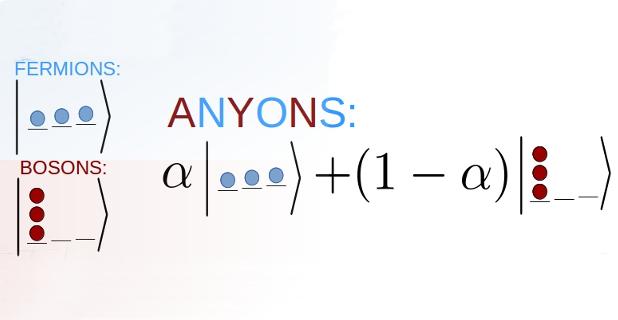New approach to exotic quantum matter

When the energy levels of a quantum system are filled, fermionic particles exclude each other, whereas bosonic matter can accumulate in the lowest level. In contrast, anyons behave in an intermediate fashion. The paper shows how the anyons' statistical parameter alpha can be detected from the angular momentum of impurity particles attached to the anyons.
Credit: ICFO
While in a three-dimensional world, all particles must be either fermions or bosons, it is known that in fewer dimensions, the existence of particles with intermediate quantum statistics, known as anyons, is possible. Such fascinating objects are strongly believed to exist as emerging quasiparticles in fractional quantum Hall systems, but despite great efforts, experimental evidence of anyons has remained very limited.
Since quantum statistics is defined through the behavior of the phase of the wave function, when two identical particles are exchanged, early attempts of anyon detection have been based on interferometric measurements using Fabry-Perot interferometry or beamsplitter experiments.
So far, there have been many efforts to improve the experimental evidence of anyons by searching for ways to study the FQH effect and understand its underlying physics in highly controllable quantum systems such as cold atoms or photonic quantum simulators.
There are studies that have shown that light-matter interactions can create and trap fractional quasiparticles in atomic gases or electronic systems and measure, through time-of-light imaging, signatures of fractional statistics carried by the total angular momentum of a fractional quantum Hall system.
In a recent study published in Physical Review Letters, ICFO researchers Tobias Grass, Niccolo Baldelli, and Utso Bhattacharya, led by ICREA Prof. at ICFO Maciej Lewenstein, and in collaboration with Bruno Julia-Díaz, from the University of Barcelona, describe a new approach towards anyon detection, which is a crucial element for increasing our knowledge of exotic quantum matter.
Contrary to earlier detection schemes, the study authored by the researchers opens up a new possibility which requires neither particle exchange nor interferometry. Instead, the authors suggest to trace the behavior of the anyons by binding impurity particles to them. Specifically, the average angular momentum of a single impurity is shown to take characteristic values that are possibly fractional.
For a system of multiple impurities, the total angular momentum should then depend on how these effective single-impurity levels are filled. Strikingly, the value obtained by the authors corresponds neither to the filling of a Fermi sea nor to the condensation of a bosonic mode. Instead, the impurity angular momentum interpolates between these limiting cases, and the fractional statistical parameter of the anyons can be straightaway inferred from this interpolation.
Their detection scheme only requires density measurements and might be applicable to Abelian quantum Hall phases in electronic materials as well as in photonic or atomic quantum simulators. The authors discuss also possible generalizations towards non-Abelian anyons. Since the impurities realize a non-interacting gas of anyons, their work also poses the possibility of studying the intricate thermodynamics of anyonic systems.
Media Contact
All latest news from the category: Physics and Astronomy
This area deals with the fundamental laws and building blocks of nature and how they interact, the properties and the behavior of matter, and research into space and time and their structures.
innovations-report provides in-depth reports and articles on subjects such as astrophysics, laser technologies, nuclear, quantum, particle and solid-state physics, nanotechnologies, planetary research and findings (Mars, Venus) and developments related to the Hubble Telescope.
Newest articles

You are What You Eat—Stanford Study Links Fiber to Anti-Cancer Gene Modulation
The Fiber Gap: A Growing Concern in American Diets Fiber is well known to be an important part of a healthy diet, yet less than 10% of Americans eat the minimum recommended…

Trust Your Gut—RNA-Protein Discovery for Better Immunity
HIRI researchers uncover control mechanisms of polysaccharide utilization in Bacteroides thetaiotaomicron. Researchers at the Helmholtz Institute for RNA-based Infection Research (HIRI) and the Julius-Maximilians-Universität (JMU) in Würzburg have identified a…

ASXL1 Mutation: The Hidden Trigger Behind Blood Cancers and Inflammation
Scientists show how a mutated gene harms red and white blood cells. LA JOLLA, CA—Scientists at La Jolla Institute for Immunology (LJI) have discovered how a mutated gene kicks off…



